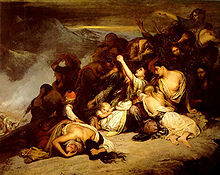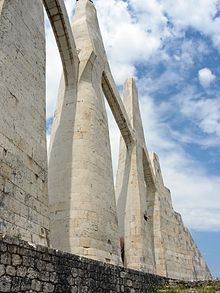- Dance of Zalongo
-
The term Dance of Zalongo refers to an event in Greek history involving a mass suicide of women from Souli and their children during the Souliote war of 1803, near the village of Zalongo in Epirus. The name also refers to popular dance song commemorating the event.[1] The same event made and impact in Albanian history[citation needed]. There is also an Albanian song and dance on the same topic, called Vaji i Zallogut ("Dance of Zalongo")[2][verification needed]
Contents
History
During the Souliote War in December 1803, the Souliotes began evacuating Souli after their defeat by Ali Pasha's forces.[3] During the evacuation, a small group of Souliot women and their children were trapped by Ottoman troops in the mountains of Zalongo in Epirus.[4] In order to avoid capture and enslavement, the women threw first their children and then themselves off a steep cliff, committing suicide.[5] According to the legend, they jumped down the precipice one after the other.[6] while singing and dancing. The incident soon became known across Europe. At the Paris Salon of 1827, the French artist Ary Scheffer exhibited two Romantic paintings, one of which was entitled Les Femme souliotes ("The Souliot Women").[7] Today, a monument on the site of Mount Zalongo in Kassope commemorates their sacrifice.[8]
Songs
There is a popular Greek dance-song about the event, which is known and danced throughout Greece today.[9] The Greek folk song "Dance of Zalongo" has the following lyrics:
English Greek Farewell poor world,
Farewell sweet life,
and you, my poor country,
Farewell for ever
Farewell springs,
Valleys, mountains and hills
Farewell springs
And you, women of Souli
The fish cannot live on the land
Nor the flower on the sand
And the women of Souli
Cannot live without freedom
Farewell springs,
...
The women of Souli
Have not only learnt how to survive
They also know how to die
Not to tolerate slavery
Farewell springs,
...Έχε γεια καημένε κόσμε,
έχε γεια γλυκιά ζωή
Και ’συ δύστυχη πατρίδα
έχε γεια παντοτινή.
Έχετε γεια βρυσούλες
λόγγοι, βουνά, ραχούλες
Έχετε γεια βρυσούλες
και σεις Σουλιωτοπούλες
Στη στεριά δε ζει το ψάρι
ούτ’ ανθός στην αμμουδιά
Κι οι Σουλιώτισσες δεν ζούνε
δίχως την ελευθεριά.
Έχετε γεια βρυσούλες
...
Οι Σουλιώτισσες δε μάθαν
για να ζούνε μοναχά
Ξέρουνε και να πεθαίνουν
να μη στέργουν στη σκλαβιά.
Έχετε γεια βρυσούλες
...The following is an Albanian song and dance on the same topic, called Vaji i Zallogut ("Dance of Zalongo")[10]
English Albanian Mosko1 afoot, has left her baby in the ground,
Hits this woman, this brave woman,
Her gun and cannon everything scares.
"Look here girls, how close they are!"
Even walls became ash, but Dhespo1 as always stands up,
To her girls speaks, with voice and calamity.
"Girls, slaves of the Turkish can we be?
Follow me, girls, our place is down there!"Moskua në këmbë, foshnjën përdhe ka lënë,
Qëllon a s’qëllon kjo grua, deli grua,
Pushka top gjithçka zhurit.
"Vështrojuni një çikë more, si jeni bërë meit!"
Edhe muret u bënë hi, po Dhespua përherë në këmbë,
Nuseve ç’u thërret, me zë e me gjëmë.
“Skllave të turkut bija, a mund të bëhemi ne?
Pas meje, mori nuse, vendin e kemi atje!"1 Dhespo is the wife of Giorgos Botsaris and Mosko was the wife of Lambros Tzavelas.
See also
References
- ^ Royal Society of Canada (1943), p. 100; JSTOR (Organization) (1954), p. 39.
- ^ Sako, Zihni. "Mbledhës të hershëm të folklorit Shqiptar (1635-1912)", Tirana, 1962.
- ^ Sakellariou (1997), pp. 250-251.
- ^ Sakellariou (1997), pp. 250-251.
- ^ Royal Society of Canada (1943), p. 100; JSTOR (Organization) (1954), p. 39; Papaspyrou-Karadēmētriou, Lada-Minōtou, and Ethniko Historiko Mouseio (1994), p. 47; Pritchett (1996), p. 103.
- ^ JSTOR (1954), p. 39; Mynatt and Kaiman (1968), p. 28.
- ^ Athanassoglou-Kallmyer (1989), p. 102.
- ^ Pritchett (1991), p. 219 - Footnote #326; Pritchett (1996), p. 103.
- ^ JSTOR (Organization) (1954), p. 39.
- ^ Sako, Zihni. "Mbledhës të hershëm të folklorit Shqiptar (1635-1912)", Tirana, 1962.
Sources
- Athanassoglou-Kallmyer, Nina M. (1989). French Images from the Greek War of Independence (1821-1830): Art and Politics under the Restoration. Yale University Press. ISBN 0300045328. http://books.google.com/books?id=unXeZpkaxTMC.
- JSTOR (Organization) (1954). Journal of the International Folk Music Council, Volumes 6-10. Published with the assistance of the International Music Council, under the auspices of United Nations Educational Scientific and Cultural Organisation for the International Folk Music Council by W. Heffer, 1954. http://books.google.com/books?id=WpI5AAAAIAAJ.[clarification needed]
- Mynatt, Constance Virginia; Kaiman, Bernard D. (1968). Folk Dancing for Students and Teachers. Wm. C. Brown Co. http://books.google.com/books?id=monkAAAAMAAJ.
- Papaspyrou-Karadēmētriou, Euthymia; Lada-Minōtou, Maria; Ethniko Historiko Mouseio (Greece) (1994). The National Historical Museum. Historical and Ethnological Society of Greece. ISBN 9608557305. http://books.google.com/books?cd=1&id=mj1oAAAAMAAJ.
- Pritchett, William Kendrick (1996). Greek Archives, Cults, and Topography. J.C. Gieben. ISBN 9050631479. http://books.google.com/books?id=zgAdAAAAYAAJ.
- Pritchett, William Kendrick (1991). The Greek State at War, Volume 5. University of California Press. ISBN 0520073746. http://books.google.com/books?id=z1kbyWNJIt0C.
- Royal Society of Canada (1943). Mémoires de la Société royale du Canada. Royal Society of Canada. http://books.google.com/books?id=NGUYAQAAIAAJ.
- Sakellariou, M. V. (1997). Epirus: 4000 Years of Greek History and Civilization. Ekdotike Athenon. ISBN 9602133716. http://books.google.com/books?id=UV1oAAAAMAAJ.
Souliotes History Greek War of Independence · Souliote Confederacy · Souliote War (1803) · Epirus Revolt of 1854Main Settlements Souli · Navariko · Kiafa · SamonivaCulture Dance of ZalongoIndividuals Markos Botsaris · Kitsos Tzavelas · Kostas Botsaris · Katerina Botsari · Kitsos Botsaris · Lambros Tzavelas · Moscho Tzavela · Nikolaos Zervas
Ai Georgis · Angaliastos · Antikristos · Antipatitis · Antistrophe · Atsiapat · Ballos · Byzantine dance · Caryatid's dance · Choros tis palestras · Dance of Zalongo · Dionysiakos · Dipat · Diplos Horos · Endeka Kozanis · Fisouni · Gaitanaki · Gerakina · Hasapiko · Hatzichristos · Horon · Horos · Ikariotikos · Kalamatianó · Kalamatianos · Kalymnikos · Kamilierikos · Kanella · Kangeli · Kapitan Louka · Kastorianos · Katsabadianos · Kerkiraikos · Kinigitos · Kleftes (dance) · Kleistos · Kochari · Koftos · Koutsos · Lafina · Lambri Kamara · Lasithiotikos · Lerikos · Levantinikos · Leventikos · Loulouvikos · Makedonia · Makedonikos antikristos · Makrinitsa dance · Maniatikos · Metsovitikos · Mihanikos · Monodiplos · Mpougatsas · Nisiotika · Nizamikos · Ntames · Ntournerakia · Omal · Omorfoula · O Nikolos · Opa (dance) · Palamakia · Partalos · Pentozali · Pidikhtos · Pizzica · Podaraki · Poustseno · Priniotis · Proskinitos · Pyrrhichios · Rhoditikos · Rodo (dance) · Rougatsiarikos · Rebetiko · Serra · Sirtaki · Sousta · Syrtos · Stamoulo · Tambouras · Tamzara · Tapeinos Horos · Thessalikos · Tis Triandafilias Ta Fila · Tranos Choros · Trata · Trizalis · Tromakton · Tsakonikos · Tsamiko · Tsestos · Tsifteteli · Tsiniaris · Yikna · Zaramo · Zeibekiko · Zervodexios · Zervos · Zonaradiko
Categories:- Souliotes
- Ottoman Greece
- Greek dances
- Mass suicides
- History of Epirus
- Albanian dances
- Cham Albanians
Wikimedia Foundation. 2010.


